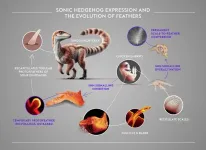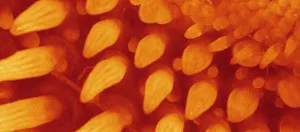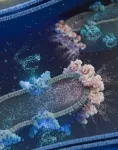(Press-News.org) Inhibiting the sonic hedgehog (Shh) pathway strongly perturbs feather development in chickens by restricting feather bud outgrowth, invagination and branching, according to a study published March 20th, in the open-access journal PLOS Biology by Rory Cooper and Michel Milinkovitch from the University of Geneva, Switzerland.
Avian feathers are intricate appendages whose forms vary substantially across species and body areas, and between juvenile and adult stages. Understanding both the developmental and evolutionary mechanisms underpinning this morphological diversity has long fascinated biologists. The morphological intricacies of avian feathers make them an ideal model for investigating embryonic patterning. In particular, the Shh pathway is an important mediator of feather outgrowth and branching. However, functional in-vivo evidence regarding its role during feather development remains limited.
To fill this knowledge gap, Cooper and Milinkovitch used light sheet fluorescence microscopy imaging to study the normal patterning of embryonic feathers and how their shape develops. The authors also used precise intravenous injections of sonidegib to pharmacologically inhibit Shh pathway signaling during feather development at embryonic day 9, which precedes feather-bud outgrowth on the wings. This treatment temporarily modified Shh expression to produce striped domains instead of spots on the skin, temporarily stopped feather development, and resulted in unbranched and non-invaginated feather buds — akin to putative proto-feathers —until embryonic day 14.
Although feather development partially recovered later during development, hatched sonidegib-treated chickens exhibited naked regions of the skin surface with perturbed follicles. Remarkably, these follicles were subsequently reactivated by seven weeks post-hatching, highlighting the robustness of feather patterning as a developmental process. Overall, the study provides comprehensive functional evidence for the role of the Shh pathway in mediating feather development in chickens, supporting the idea that modified Shh signaling has contributed to the evolutionary diversification of feathers and other skin appendages such as feet scales. According to the authors, the study also demonstrates the importance of in-vivo experiments for obtaining a comprehensive understanding of developmental systems.
The authors add, “Our experiments show that while a transient disturbance in the development of feet scales can permanently turn them into feathers, it is much harder to disrupt feather development itself. The big challenge now is to understand how these genetic interactions have changed to allow for the emergence of protofeathers early in the evolution of dinosaurs."
In your coverage, please use this URL to provide access to the freely available paper in PLOS Biology: https://plos.io/3XLN4RU
Citation: Cooper RL, Milinkovitch MC (2025) In vivo sonic hedgehog pathway antagonism temporarily results in ancestral proto-featherlike structures in the chicken. PLoS Biol 23(3): e3003061. https://doi.org/10.1371/journal.pbio.3003061
Author countries: Switzerland
Funding: see manuscript
END
How feathers develop in chickens
The sonic hedgehog pathway may underlie the evolutionary emergence and diversity of feathers
2025-03-20
ELSE PRESS RELEASES FROM THIS DATE:
Insomniac fruit fly mutants show enhanced memory despite severe sleep loss
2025-03-20
Fruit fly mutants that have severe sleep deficits perform better at olfactory learning and memory tasks, according to a study published March 20th in the open-access journal PLOS Biology by Sheng Huang and Stephan Sigrist from Freie Universität Berlin, Germany, and colleagues. The paradox of enhanced memory despite sleep loss could be explained by protein kinase A (PKA) signaling in the mushroom body of the fly brain.
Sleep is a dynamic process conserved from invertebrates to mammals and humans. Although sleep is thought to serve many purposes, it is often studied for its restorative roles, which ...
Seals can sense their own circulating blood oxygen and it keeps them from drowning
2025-03-20
Marine mammals may have a secret weapon to survive long dives – an ability to directly sense their own circulating blood-oxygen levels that most mammals lack – allowing them to stay submerged longer and resurface before hypoxia leads to drowning, researchers report. Air-breathing marine mammals have developed a range of physiological adaptations to survive in aquatic environments, including thermoregulation to endure the pressures of the deep. However, one of the most critical evolutionary challenges for diving mammals is avoiding drowning. Despite adaptations for larger oxygen storage and tolerance to low oxygen levels, these animals still risk drowning if they ...
Infants encode short-lived hippocampal memories
2025-03-20
Challenging assumptions about infant memory, a novel functional magnetic resonance imaging (fMRI) study shows that babies as young as 12 months old can encode memories, researchers report. The findings suggest that infantile amnesia – the inability to remember our first few years of life – is more likely caused by memory retrieval failures rather than an inability to form memories in the first place. Despite infancy being a period of rapid learning, memories from this time do not persist into later childhood or adulthood. In ...
Mountain uplift and dynamic topography shapes biodiversity over deep time
2025-03-20
Rising mountains do more than reshape the landscape – they also drive evolutionary change, according to a new study. By simulating millions of years of tectonic uplift, researchers have uncovered a link between mountain building and biodiversity, shedding light on how Earth’s dynamic topography shapes biodiversity over deep time. Mountain ranges are widely recognized as global hotspots of terrestrial biodiversity yet only cover a relatively small proportion of the Earth’s surface, suggesting a strong connection between topographic evolution and species diversity. Mountainous terrain can promote speciation by isolating populations, ...
Majority of carbon sequestered on land is locked in nonliving carbon reservoirs
2025-03-20
Challenging long-held assumptions about global terrestrial carbon storage, a new study finds that the majority of carbon dioxide (CO2) absorbed by ecosystems has been locked away in dead plant material, soils, and sediments, rather than living biomass, researchers report. These new insights, which suggest that terrestrial carbon stocks are more resilient and stable than previously appreciated, are crucial for shaping future climate mitigation strategies and optimizing carbon sequestration efforts. Recent studies have shown that terrestrial carbon stocks are increasing, offsetting ...
From dinosaurs to birds: the origins of feather formation
2025-03-20
Feathers are among the most complex cutaneous appendages in the animal kingdom. While their evolutionary origin has been widely debated, paleontological discoveries and developmental biology studies suggest that feathers evolved from simple structures known as proto-feathers. These primitive structures, composed of a single tubular filament, emerged around 200 million years ago in certain dinosaurs. Paleontologists continue to discuss the possibility of their even earlier presence in the common ancestor of dinosaurs and pterosaurs (the first flying vertebrates with membranous wings) around 240 million years ago.
Proto-feathers are ...
Why don’t we remember being a baby? New study provides clues
2025-03-20
Though we learn so much during our first years of life, we can’t, as adults, remember specific events from that time. Researchers have long believed we don’t hold onto these experiences because the part of the brain responsible for saving memories — the hippocampus — is still developing well into adolescence and just can’t encode memories in our earliest years. But new Yale research finds evidence that’s not the case.
In a study, Yale researchers showed infants ...
The cell’s powerhouses: Molecular machines enable efficient energy production
2025-03-20
Mitochondria are the powerhouses in our cells, producing the energy for all vital processes. Using cryo-electron tomography, researchers at the University of Basel, Switzerland, have now gained insight into the architecture of mitochondria at unprecedented resolution. They discovered that the proteins responsible for energy generation assemble into large “supercomplexes”, which play a crucial role in providing the cell’s energy.
Most living organisms on our planet-whether plants, animals, or ...
Most of the carbon sequestered on land is stored in soil and water
2025-03-20
Recent studies have shown that carbon stocks in terrestrial ecosystems are increasing, mitigating around 30% of the CO2 emissions linked to human activities. The overall value of carbon sinks on the earth's surface is fairly well known—as it can be deduced from the planet's total carbon balance anthropogenic emissions, the accumulation of carbon in the atmosphere and the ocean sinks—yet, researchers know very little about carbon distribution between the various terrestrial pools: living vegetation—mainly forests—and nonliving carbon pools—soil organic matter, sediments at the bottom of lakes and rivers, wetlands, ...
New US Academic Alliance for the IPCC opens critical nomination access
2025-03-20
WASHINGTON — The American Geophysical Union and the U.S. Academic Alliance for the IPCC today open calls for U.S. researchers to self-nominate as experts, authors and review editors for the Intergovernmental Panel on Climate Change Seventh Assessment Report through a new application portal. The IPCC nomination period opened in early March and will close in mid-April.
USAA-IPCC is a newly established network of U.S. academic institutions registered as observers with the IPCC. Both observer organizations and governments may nominate experts for ...
LAST 30 PRESS RELEASES:
Injectable breast ‘implant’ offers alternative to traditional surgeries
Neuroscientists devise formulas to measure multilingualism
New prostate cancer trial seeks to reduce toxicity without sacrificing efficacy
Geometry shapes life
A CRISPR screen reveals many previously unrecognized genes required for brain development and a new neurodevelopmental disorder
Hot flush treatment has anti-breast cancer activity, study finds
Securing AI systems against growing cybersecurity threats
Longest observation of an active solar region
Why nail-biting, procrastination and other self-sabotaging behaviors are rooted in survival instincts
Regional variations in mechanical properties of porcine leptomeninges
Artificial empathy in therapy and healthcare: advancements in interpersonal interaction technologies
Why some brains switch gears more efficiently than others
UVA’s Jundong Li wins ICDM’S 2025 Tao Li Award for data mining, machine learning
UVA’s low-power, high-performance computer power player Mircea Stan earns National Academy of Inventors fellowship
Not playing by the rules: USU researcher explores filamentous algae dynamics in rivers
Do our body clocks influence our risk of dementia?
Anthropologists offer new evidence of bipedalism in long-debated fossil discovery
Safer receipt paper from wood
Dosage-sensitive genes suggest no whole-genome duplications in ancestral angiosperm
First ancient human herpesvirus genomes document their deep history with humans
Why Some Bacteria Survive Antibiotics and How to Stop Them - New study reveals that bacteria can survive antibiotic treatment through two fundamentally different “shutdown modes”
UCLA study links scar healing to dangerous placenta condition
CHANGE-seq-BE finds off-target changes in the genome from base editors
The Journal of Nuclear Medicine Ahead-of-Print Tip Sheet: January 2, 2026
Delayed or absent first dose of measles, mumps, and rubella vaccination
Trends in US preterm birth rates by household income and race and ethnicity
Study identifies potential biomarker linked to progression and brain inflammation in multiple sclerosis
Many mothers in Norway do not show up for postnatal check-ups
Researchers want to find out why quick clay is so unstable
Superradiant spins show teamwork at the quantum scale
[Press-News.org] How feathers develop in chickensThe sonic hedgehog pathway may underlie the evolutionary emergence and diversity of feathers




